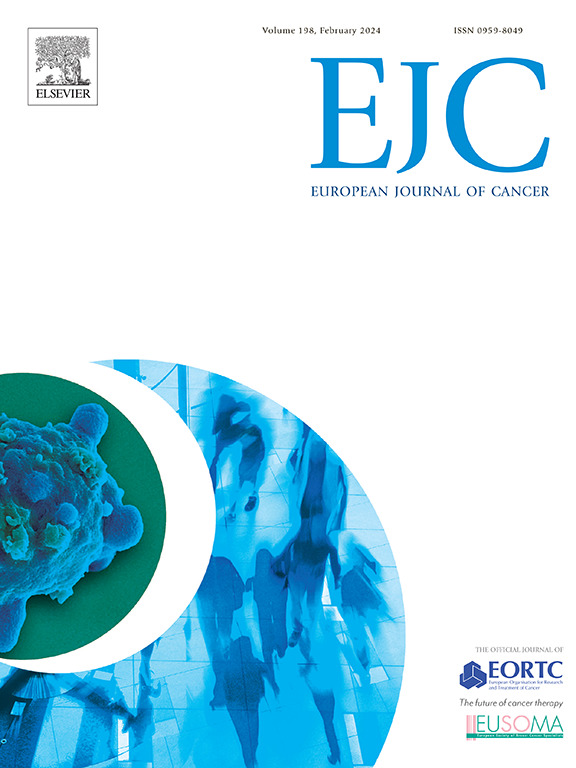Liquid biopsy with plasma Epstein-Barr virus DNA characterizes biological relapse for the prediction of cancer recurrence in non-disseminated nasopharyngeal carcinoma
IF 7.6
1区 医学
Q1 ONCOLOGY
引用次数: 0
Abstract
Purpose
To investigate whether a bounce in plasma Epstein-Barr virus (EBV) DNA during posttreatment surveillance of nasopharyngeal carcinoma (NPC) informs the risk of clinical recurrence and its implication for early therapeutic intervention.
Methods
950 non-disseminated NPC patients with completed remission in 3 months after treatment were retrospectively screened. Detectable EBV DNA with no evidence of clinical relapse during follow-up was deemed as DNA bounce. The diagnostic and prognostic performance of EBV DNA bounce was assessed for subsequent failures.
Results
Tumor recurrence occurred in 6.6 %, 10.1 % and 65.8 % in the group with persistently negative EBV DNA, single positive test and ≥ 2 positive tests, respectively. EBV DNA bounce over twice was associated with worse disease-free survival (DFS), locoregional recurrence-free survival (LRRFS), and distant metastasis-free survival (DMFS) than the other two groups. Sensitivity, specificity, positive predictive value (PPV), negative predictive value (NPV) and accuracy for the prediction of recurrence were 0.56, 0.95, 0.66, 0.93 and 0.90 using two positive tests, which were hence deemed as biological relapse. Serial cutoffs (EBV DNA 1 ≥ 40 copies/ml or EBV DNA 2 ≥100 copies/ml) further defined a high-risk subgroup with an eventual recurrence rate of 77.9 % and 3-year DFS of merely 20.5 %. Prophylactic medical intervention with capecitabine or S1 significantly improved the 3-year DFS when compared to those with observation.
Conclusions
The earliest two positive tests of EBV DNA represent a biomarker of biological relapse that allows early detection of clinical recurrence in EBV-related NPC. For high-risk biological relapse, preemptive intervention provides potential survival benefits.
利用血浆 Epstein-Barr 病毒 DNA 进行液体活检可确定生物复发的特征,从而预测非扩散性鼻咽癌的复发情况
目的研究在鼻咽癌(NPC)治疗后监测期间,血浆中爱泼斯坦-巴氏病毒(EBV)DNA的反弹是否能告知临床复发的风险及其对早期治疗干预的影响。可检测到 EBV DNA 且随访期间无临床复发证据的患者被视为 DNA 反弹。结果EBV DNA持续阴性组、单次检测阳性组和≥2次检测阳性组的肿瘤复发率分别为6.6%、10.1%和65.8%。与其他两组相比,EBV DNA反跳两次以上与更差的无病生存期(DFS)、无局部复发生存期(LRRFS)和无远处转移生存期(DMFS)相关。预测复发的灵敏度、特异性、阳性预测值(PPV)、阴性预测值(NPV)和准确度分别为 0.56、0.95、0.66、0.93 和 0.90(使用两次阳性测试,因此被视为生物学复发)。序列截断值(EBV DNA 1 ≥ 40拷贝/毫升或EBV DNA 2 ≥ 100拷贝/毫升)进一步定义了高风险亚组,其最终复发率为77.9%,3年DFS仅为20.5%。与观察组相比,使用卡培他滨或 S1 进行预防性医疗干预可显著改善 3 年 DFS。对于高风险的生物复发,先期干预可为患者带来潜在的生存益处。
本文章由计算机程序翻译,如有差异,请以英文原文为准。
求助全文
约1分钟内获得全文
求助全文
来源期刊

European Journal of Cancer
医学-肿瘤学
CiteScore
11.50
自引率
4.80%
发文量
953
审稿时长
23 days
期刊介绍:
The European Journal of Cancer (EJC) serves as a comprehensive platform integrating preclinical, digital, translational, and clinical research across the spectrum of cancer. From epidemiology, carcinogenesis, and biology to groundbreaking innovations in cancer treatment and patient care, the journal covers a wide array of topics. We publish original research, reviews, previews, editorial comments, and correspondence, fostering dialogue and advancement in the fight against cancer. Join us in our mission to drive progress and improve outcomes in cancer research and patient care.
 求助内容:
求助内容: 应助结果提醒方式:
应助结果提醒方式:


